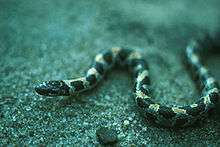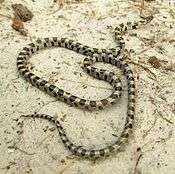Short-tailed snake
| Short-tailed snake | |
|---|---|
 | |
| Scientific classification | |
| Kingdom: | Animalia |
| Phylum: | Chordata |
| Class: | Reptilia |
| Order: | Squamata |
| Suborder: | Serpentes |
| Family: | Colubridae |
| Genus: | Lampropeltis |
| Species: | L. extenuatum |
| Binomial name | |
| Lampropeltis extenuatum (Brown, 1890) | |
| Synonyms | |
The short-tailed snake (Lampropeltis extenuatum) is a small harmless colubrid snake. Fossorial and seldom seen, it is found only in sandy, upland parts of Florida where it is listed as Threatened and is protected by state law.
Etymology

The short-tailed snake's tail comprises less than ten percent of the snake's total length, hence the common name. Named by A. Erwin Brown in 1890,[3] Stilosoma extenuatum derives its generic name from the Greek stylos for pillar and soma for body. This refers to the stiffness of the short-tailed snake's body,[4] which is caused by its wide and inflexible column of unusually short vertebrae. The specific name, extenuatum, is Latin for thin or slender.
Description
The short-tailed snake is a small serpent averaging 36–51 cm (14–20 in) in total length, with a record total length measurement of 65.4 cm (25 3⁄4 in),[5] and is perhaps as thin as a pencil. It is gray above with 50 to 80 dark blotches and may or may not have a yellow stripe running down the spine. The underside is white with dark brown blotches. It bears a more-than-superficial resemblance to other kingsnakes, especially the mole kingsnake (Lampropeltis calligaster rhombomaculata), but can be distinguished by its smaller size and much more slender build.[6] Also, Lampropeltis extenuatum has 6 upper labials, whereas kingsnakes (genus Lampropeltis) have 7 upper labials.[7]
Behavior

The short-tailed snake is as poorly understood as it is seldom-seen, rare and geographically limited. It is a burrowing snake that rarely appears above ground and does so even more rarely during the day. Like other snakes of the tribe Lampropeltini, it vibrates its tail when startled by predators or people but can be distinguished from a rattlesnake by its slender build and lack of rattle. An excitable snake, it makes a poor captive and is protected against harassment or captivity by Florida law. Despite this, much of what little we know about the short-tailed snake has been based on observations of captive specimens.
Diet
Captive specimens show a keen preference for black-crowned snakes of the genus Tantilla and will often eat them exclusively, rejecting other species of small snake or lizard. It is possible that black-crowned snakes, some of which are themselves small, burrowing snakes endemic to Florida, comprise the entire diet of wild short-tailed snakes.
Habitat and range
Found only in a handful of counties in central Florida, the short-tailed snake prefers sandy-soiled, pine or oak woodlands but may be found in other habitats provided it has access to prey and suitable soil for burrowing.
Evolution and taxonomy
As a member of the tribe Lampropeltini, L. extenuata is ultimately derived from Old World rat snakes that crossed the Bering Land Bridge into North America more than 20 million years ago.[8] More recently, L. extenuata is a relict of the Miocene "Florida Island", separated from the mainland by higher sea levels. It is closely related to the kingsnakes and still bears a resemblance to the mole kingsnakes which are also found in Florida. One fossil species, Stilosoma vetustum, dates from the late Miocene, some 5-10 million years ago.[9] How far divergent L. extenuata is from its kingsnake ancestors is still a matter of debate. In 2009 Pyron and Burbrink resolved to include it in the kingsnake genus Lampropeltis based on multiple lines of molecular and morphological evidence obtain in theirs and earlier studies.[10]
References
- ↑ Highton, R. 1956. Systematics and Variation of the Endemic Florida Snake Genus Stilosoma. Bull. Florida State Mus., Biol. Sci. 1 (2): 73-96. ("Taxonomy and Nomenclature", pp. 80-82.)
- ↑ The Reptile Database. www.reptile-database.org.
- ↑ Boulenger, G.A. 1894. Catalogue of the Snakes in the British Museum (Natural History). Volume II., Containing the Conclusion of the Colubridæ Aglyphæ. Trustees of the British Museum (Natural History). (Taylor and Francis, Printers.) London. xi + 382 pp. + Plates I.- XX. (Stilosoma extenuatum, p. 325.)
- ↑ Schmidt, K.P., and D.D. Davis. 1941. Field Book of Snakes of the United States and Canada. G.P. Putnam's Sons. New York. 365 pp. (Stilosoma extenuatum, pp. 191-192, Figure 59. + Plate 21.)
- ↑ Conant, R. 1975. A Field Guide to Reptiles and Amphibians of Eastern and Central North America, Second Edition. Houghton Mifflin. Boston. 429 pp.
ISBN 0-395-19977-8 (paperback). (Stilosoma extenuatum, p. 213 + Plate 21 + Map 162.) - ↑ Wright, A.H., and A.A. Wright. 1957. Handbook of Snakes of the United States and Canada. Comstock. Ithaca and London. 1,105 pp. (in 2 volumes) (Genus Stilosoma, p. 692; and Stilosoma extenuatum, pp. 693-696, Map 52 + Figure 204. on p. 698.)
- ↑ Smith, H.M., and E.D. Brodie, Jr. 1982. Reptiles of North America: A Guide to Field Identification. Golden Press. New York. 240 pp. ISBN 0-307-13666-3 (paperback). (Stilosoma extenuatum, pp. 178-179.)
- ↑ Burbrink, F. T.; Lawson, R. (2007). "How and when did Old World ratsnakes disperse into the New World?". Molecular Phylogenetics and Evolution. 43: 173–189. PMID 17113316. doi:10.1016/j.ympev.2006.09.009.
- ↑ Pyron, R. A.; Burbrink, F. T. (2012). "Trait-dependent diversification and the impact of palaeontological data on evolutionary hypothesis testing in New World ratsnakes (tribe Lampropeltini)". Journal of Evolutionary Biology. 25 (3): 497–508. PMID 22226034. doi:10.1111/j.1420-9101.2011.02440.x.
- ↑ Pyron, R. A.; Burbrink, F. T. (2009). "Neogene diversification and taxonomic stability in the snake tribe Lampropeltini (Serpentes: Colubridae)". Molecular Phylogenetics and Evolution. 52 (2): 524–529. PMID 19236930. doi:10.1016/j.ympev.2009.02.008.
Further reading
- Brown, A.E. 1890. On a new genus of Colubridæ from Florida. Proc. Acad. Nat. Sci. Philadelphia 42: 199-200.
("Stilosoma genus nov." and "Stilosoma extenuata, species nov." ) - Carr, A.F., Jr. 1934. Notes on the Habits of the Short-Tailed Snake, Stilosoma extenuatum Brown. Copeia 1934 (3): 138–139.
External links
- Fossil snakes of North America: origin, evolution, distribution, paleoecology
- http://reptile-database.reptarium.cz/species.php?genus=Lampropeltis&species=extenuatum
- http://projectsimusflorida.synthasite.com/short-tailed-snake.php